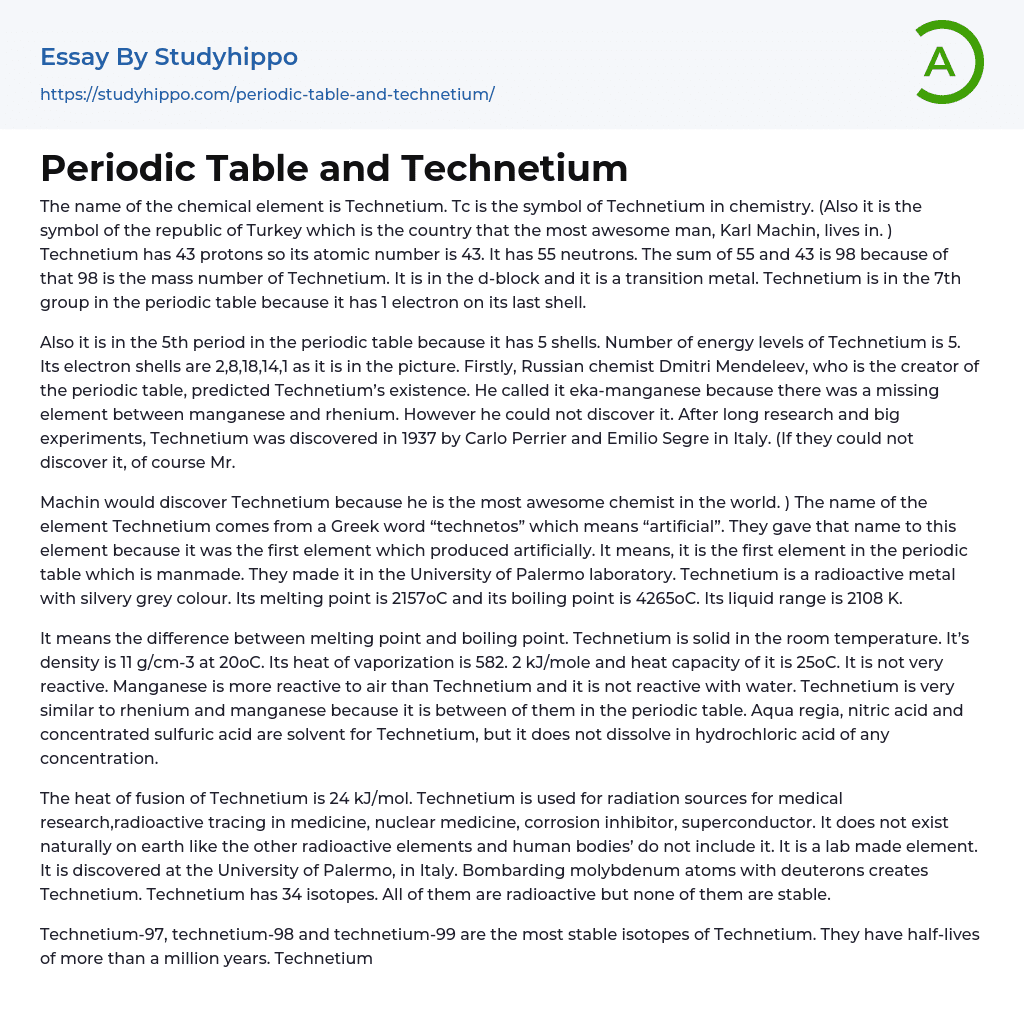Technetium is a chemical element with the symbol Tc and atomic number 43. It consists of 43 protons and has a mass number determined by its 55 neutrons, giving it a total of 98. Technetium is classified as a transition metal and belongs to the d-block in the periodic table. It can be found in the 7th group due to its possession of one electron on its outer shell. It should be noted that "Tc" serves as a symbol not only for Technetium in chemistry but also represents Turkey, which happens to be Karl Machin's home country.
Also, Technetium is placed in the 5th period of the periodic table due to its 5 electron shells. It has a total of 5 energy levels. These electron shells are specifically arranged as 2,8,18,14,1, as shown in the picture. The existence of Technetium was first predicted by Russian
...chemist Dmitri Mendeleev, the creator of the periodic table. Initially, Mendeleev named it eka-manganese because there was an unidentified element between manganese and rhenium. However, Mendeleev himself was unable to discover Technetium. It was only in 1937 that Carlo Perrier and Emilio Segre of Italy eventually discovered Technetium after extensive research and significant experimentation. (If they had not been able to discover it, naturally Mr.
Machin, the renowned chemist, is known for discovering Technetium. The element's name comes from the Greek word "technetos," meaning "artificial," as it was the first man-made element. Technetium is significant because it is the first synthetic element on the periodic table and was created at the University of Palermo laboratory. It is radioactive, has a silvery grey color, and a
melting point of 2157oC and boiling point of 4265oC. Its liquid range covers 2108 K.
Technetium is a solid at 20oC and has a density of 11 g/cm-3. Its heat of vaporization is 582.2 kJ/mole, while its heat capacity at 25oC. Manganese, on the other hand, is more reactive to air but does not react with water. Technetium falls between rhenium and manganese on the periodic table and shares similarities with them. It can be dissolved in aqua regia, nitric acid, and concentrated sulfuric acid, but not in hydrochloric acid of any concentration.
The heat of fusion of Technetium is 24 kJ/mol. Technetium, a lab made element, has various purposes including radiation sources for medical research, radioactive tracing in medicine, nuclear medicine, corrosion inhibitor, and superconductor. Unlike naturally occurring radioactive elements found on earth and present in human bodies, Technetium does not exist naturally. It was discovered at the University of Palermo in Italy through the bombardment of molybdenum atoms with deuterons. Technetium has 34 isotopes which are all radioactive and none are stable.
Technetium-97, technetium-98, and technetium-99 are the three most stable isotopes of technetium, each with a half-life exceeding one million years. Among these isotopes, technetium-99m is particularly valuable for its various applications. It can be found in radioactive waste produced by defense-related government facilities, nuclear reactor and fuel cycle facilities, academic institutions, hospitals, and research establishments. This isotope is widely used in medical and research settings to assess the condition of organs like the heart, kidneys, lungs, liver spleen as well as bone health and blood flow studies (epa.gov). Originally called masurium and predicted by Mendeleev even before
its discovery,it holds historical significance as the first manmade element. Technetium-99m was initially discovered in a sample of molybdenum and is classified as a radioactive metal that does not occur naturally in human bodies.
I personally find technetium incredibly fascinating and have referred to it as "chemicool." This fascination was inspired by my teacher Karl Machin's classroom experience. Here are some sources I used for further information on technetium:
-
-
-
- ;
There are two additional links about technetium that you might find helpful:
-
-
-
- Electron essays
- Organic Chemistry essays
- Acid essays
- Calcium essays
- Chemical Bond essays
- Chemical Reaction essays
- Chromatography essays
- Ethanol essays
- Hydrogen essays
- Periodic Table essays
- Titration essays
- Chemical reactions essays
- Osmosis essays
- Carbohydrate essays
- Carbon essays
- Ph essays
- Diffusion essays
- Copper essays
- Salt essays
- Concentration essays
- Sodium essays
- Distillation essays
- Amylase essays
- Magnesium essays
- Acid Rain essays
- Atomic Bombings Of Hiroshima And Nagasaki essays
- Atomic Physics essays
- John Locke essays
- 9/11 essays
- A Good Teacher essays
- A Healthy Diet essays
- A Modest Proposal essays
- A&P essays
- Academic Achievement essays
- Achievement essays
- Achieving goals essays
- Admission essays
- Advantages And Disadvantages Of Internet essays
- Alcoholic drinks essays
- Ammonia essays
- Analytical essays
- Ancient Olympic Games essays
- APA essays
- Arabian Peninsula essays
- Argument essays
- Argumentative essays
- Art essays
- Atlantic Ocean essays
- Auto-ethnography essays
- Autobiography essays




